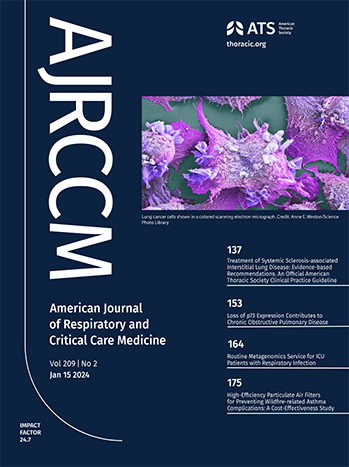哮喘性细支气管气道上皮异质性与粘液堵塞。
IF 19.4
1区 医学
Q1 CRITICAL CARE MEDICINE
American journal of respiratory and critical care medicine
Pub Date : 2025-09-23
DOI:10.1164/rccm.202409-1849oc
引用次数: 0
摘要
支气管功能障碍与哮喘加重和症状控制不良有关。然而,哮喘性细支气管疾病的分子病理生理尚不明确。目的验证哮喘性细支气管上皮生物学紊乱,产生muc5ac主导的粘液塞的假设。方法采用组织学、RNA原位杂交和免疫组织化学方法对重症哮喘患者、致死性哮喘患者和对照组的肺外组织进行评价。分离的细支气管和支气管基底细胞在培养中对IL13的反应比较。对切除的组织切片进行空间转录组学和多重免疫表型分析。在切除的组织中,严重和FA细支气管上皮,远端气道分泌细胞(DASCs)缺失,MUC5AC杯状细胞富集,MUC5AC主导的粘液塞被限制。在培养的细支气管基底细胞中,IL13抑制FOXA2和DASC基因特征,上调MUC5AC表达。在严重和FA切除组织中的进一步研究表明,细支气管上皮由表达muc5ac的杯状细胞壁龛填充,这些壁龛异质性地分布在单个细支气管内。这些表达muc5ac的细支气管壁龛的空间转录组学和免疫蛋白质组学鉴定出杯状细胞、基底上细胞(SERPINB3)和基底细胞增加,并伴有DASC基因特征的缺失。muc5ac高利基细支气管基底细胞表达FOXA2减少和2型炎症(T2)基因特征升高。哮喘性细支气管周围的免疫细胞分布与对照组不同,但与muc5ac高的生态位无关。结论哮喘性细支气管表现为t2驱动的近端化,与粘液堵塞有关。muc5ac高水平的小生境在支气管上皮中存在异质性,与免疫细胞定位无关,这表明哮喘细支气管中含有细胞小生境,使t2启动的上皮重塑持续存在。本文章由计算机程序翻译,如有差异,请以英文原文为准。
Airway Epithelial Heterogeneity and Mucus Plugging in Asthmatic Bronchioles.
RATIONALE
Bronchiolar dysfunction is associated with asthma exacerbations and poor symptom control. However, the molecular pathophysiology of asthmatic bronchiolar disease is poorly defined.
OBJECTIVES
Test the hypothesis that asthmatic bronchioles exhibit disturbances in epithelial biology that produce MUC5AC-dominated mucus plugs.
METHODS
Peripheral lung tissues from severe asthmatics, fatal asthmatics (FA), and controls were evaluated with histology, RNA in situ hybridization, and immunohistochemistry. Isolated bronchiolar and bronchial basal cell responses to IL13 were compared in culture. Spatial transcriptomics and multiplex immunophenotyping were performed on excised tissue sections.
MEASUREMENTS AND MAIN RESULTS
In excised tissues, severe and FA bronchiolar epithelia, depleted of distal airway secretory cells (DASCs) and enriched in MUC5AC goblet cells, circumscribed MUC5AC-dominated mucus plugs. In cultured bronchiolar basal cells, IL13 suppressed FOXA2 and DASC gene signatures and upregulated MUC5AC expression. Additional studies in severe and FA excised tissues demonstrated that bronchiolar epithelia were populated by MUC5AC-expressing goblet cell niches heterogeneously distributed within single segments and, indeed, individual bronchioles. Spatial transcriptomics and immuno-proteomics of these MUC5AC-expressing bronchiolar niches identified increased goblet, suprabasal (SERPINB3), and basal cell, juxtaposed to a loss of DASC, gene signatures. MUC5AC-high niche bronchiolar basal cells expressed reduced FOXA2 and elevated type-2 inflammatory (T2) gene signatures. Immune cell distributions surrounding asthmatic bronchioles differed from controls but did not correlate with MUC5AC-high niches.
CONCLUSIONS
Asthmatic bronchioles exhibit a T2-driven proximalization associated with mucus plugging. MUC5AC-high niches were identified heterogeneously in bronchiolar epithelia independent of immune cell localizations, suggesting asthmatic bronchioles contain cellular niches which perpetuate T2-initiated epithelial remodeling.
求助全文
通过发布文献求助,成功后即可免费获取论文全文。
去求助
来源期刊
CiteScore
27.30
自引率
4.50%
发文量
1313
审稿时长
3-6 weeks
期刊介绍:
The American Journal of Respiratory and Critical Care Medicine focuses on human biology and disease, as well as animal studies that contribute to the understanding of pathophysiology and treatment of diseases that affect the respiratory system and critically ill patients. Papers that are solely or predominantly based in cell and molecular biology are published in the companion journal, the American Journal of Respiratory Cell and Molecular Biology. The Journal also seeks to publish clinical trials and outstanding review articles on areas of interest in several forms. The State-of-the-Art review is a treatise usually covering a broad field that brings bench research to the bedside. Shorter reviews are published as Critical Care Perspectives or Pulmonary Perspectives. These are generally focused on a more limited area and advance a concerted opinion about care for a specific process. Concise Clinical Reviews provide an evidence-based synthesis of the literature pertaining to topics of fundamental importance to the practice of pulmonary, critical care, and sleep medicine. Images providing advances or unusual contributions to the field are published as Images in Pulmonary, Critical Care, Sleep Medicine and the Sciences.
A recent trend and future direction of the Journal has been to include debates of a topical nature on issues of importance in pulmonary and critical care medicine and to the membership of the American Thoracic Society. Other recent changes have included encompassing works from the field of critical care medicine and the extension of the editorial governing of journal policy to colleagues outside of the United States of America. The focus and direction of the Journal is to establish an international forum for state-of-the-art respiratory and critical care medicine.

 求助内容:
求助内容: 应助结果提醒方式:
应助结果提醒方式:


